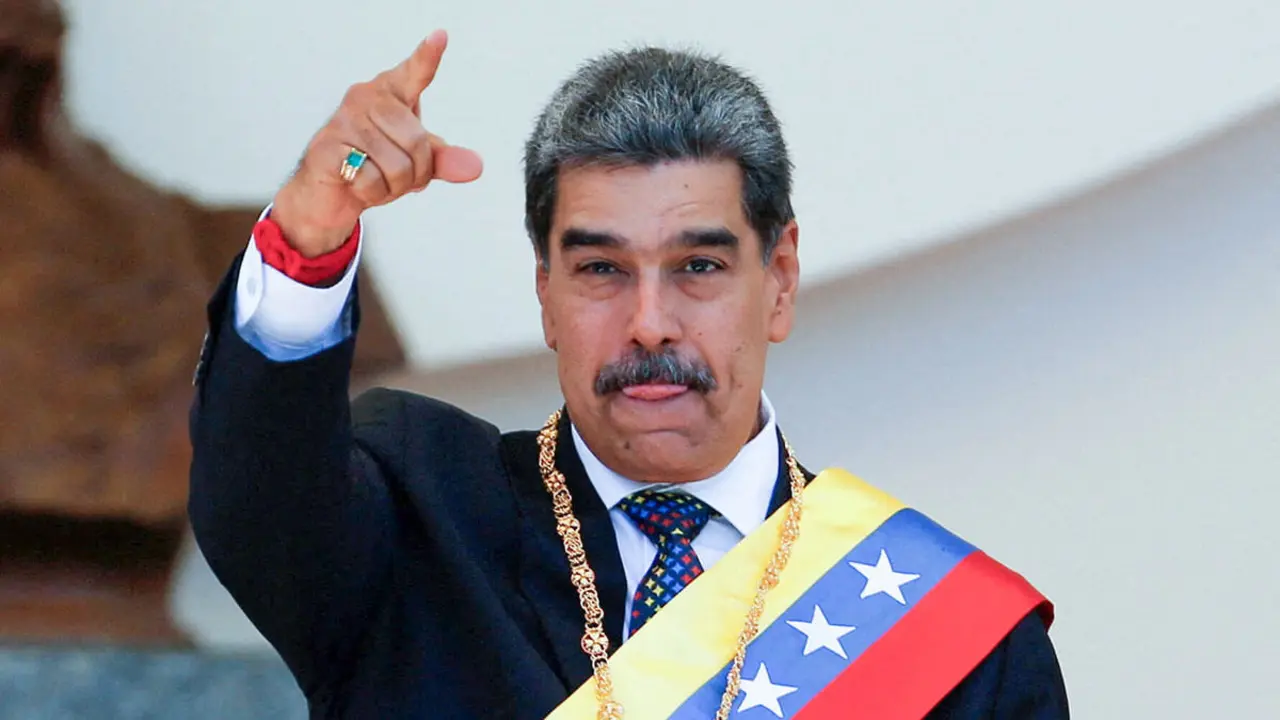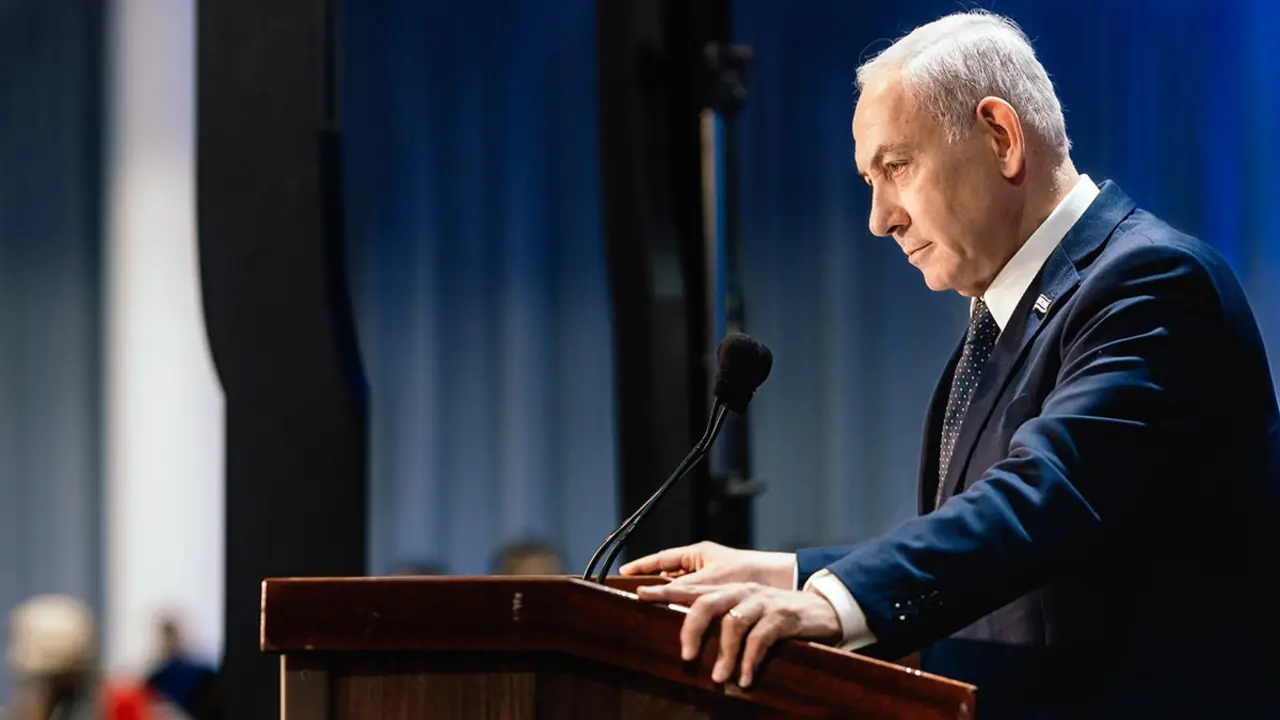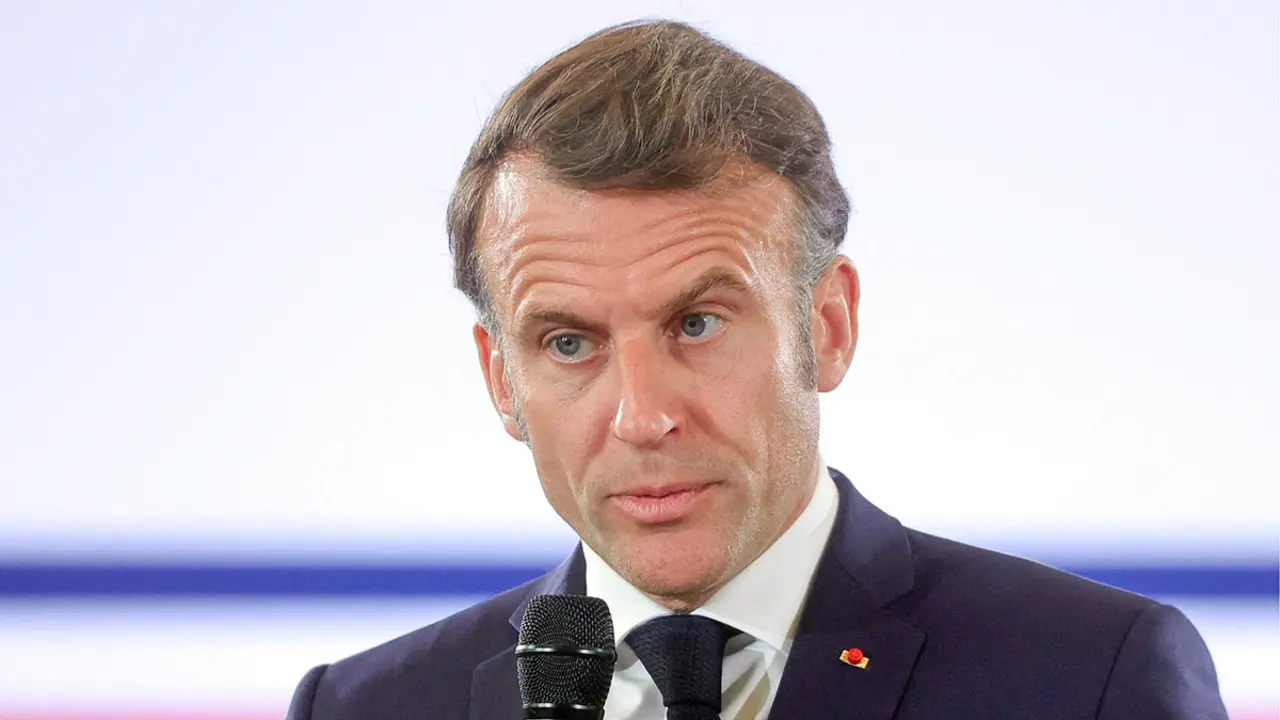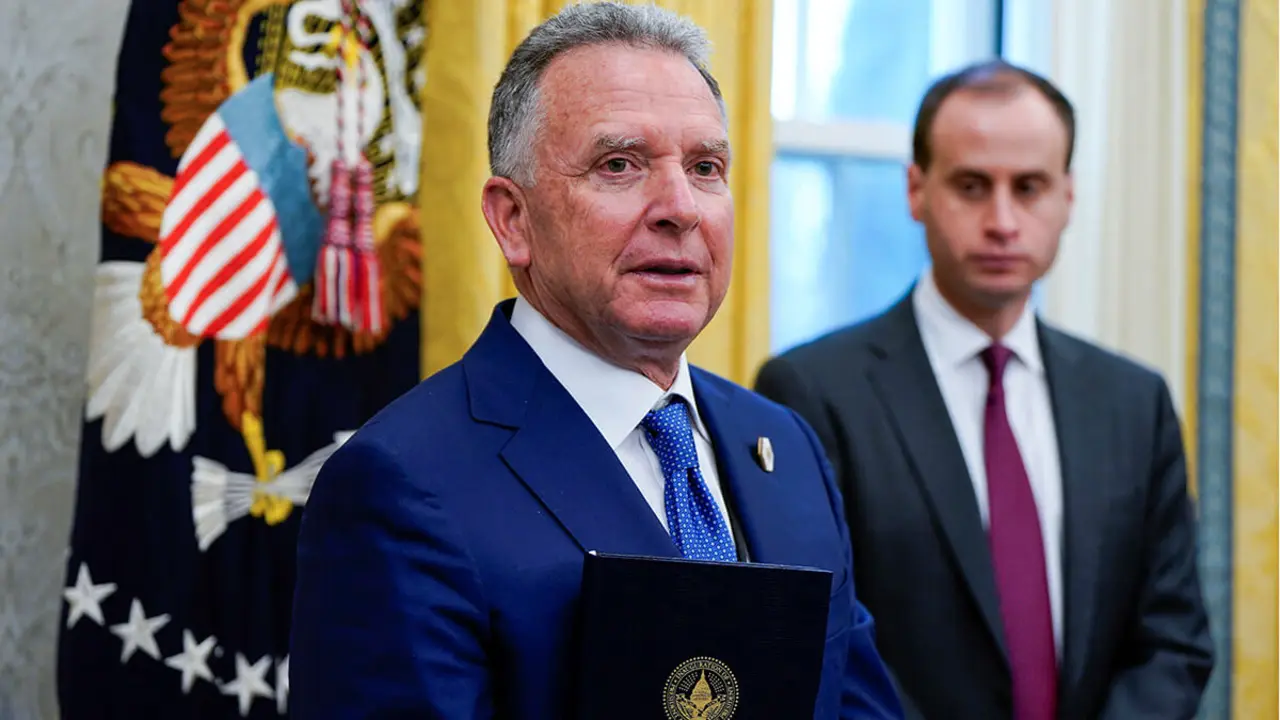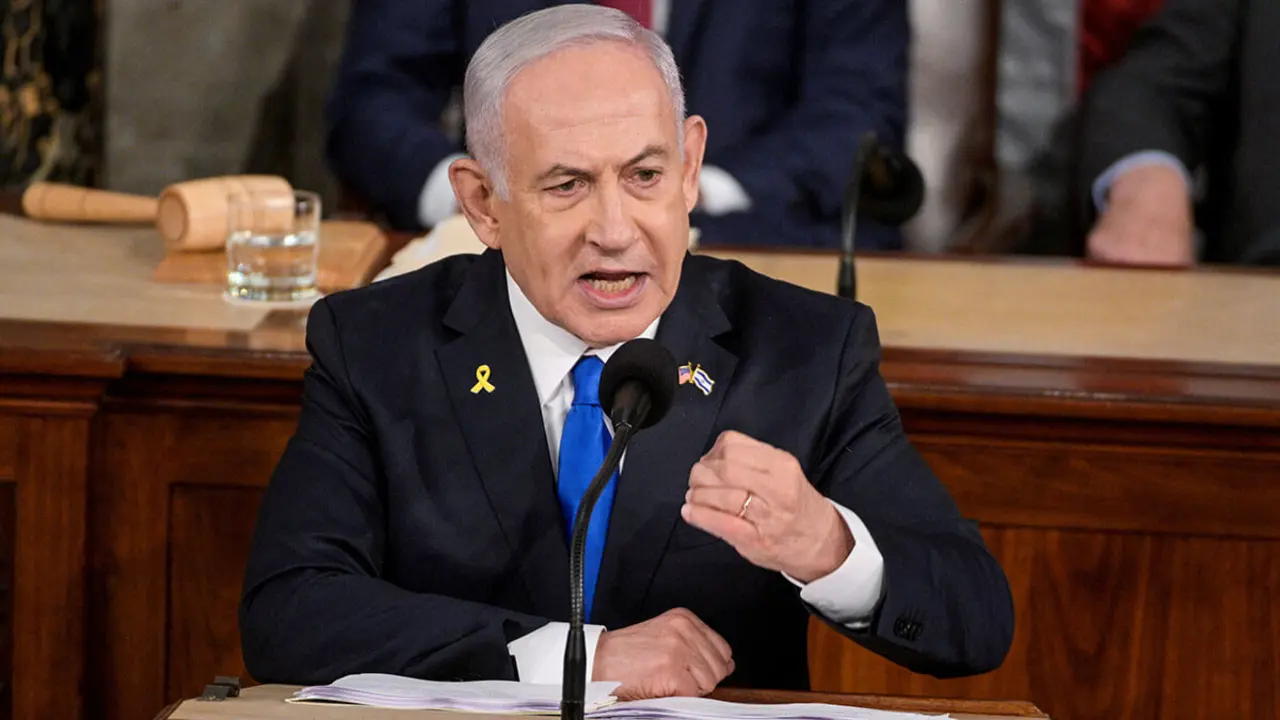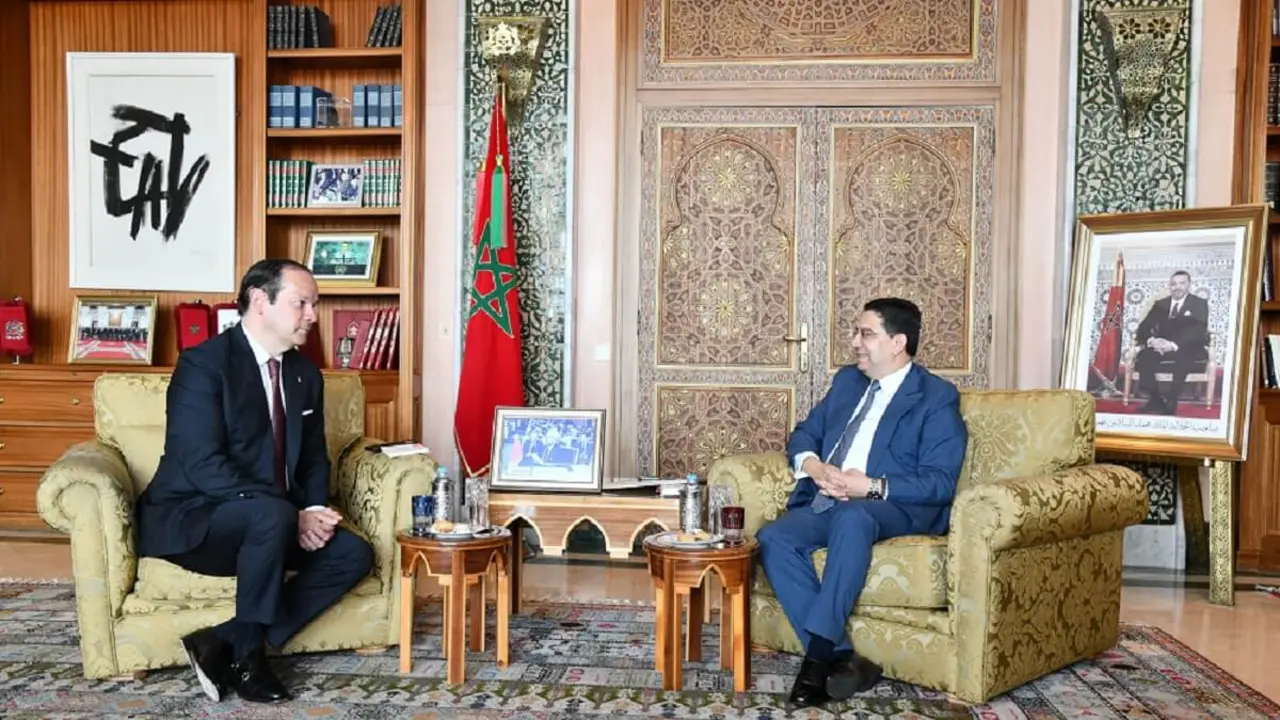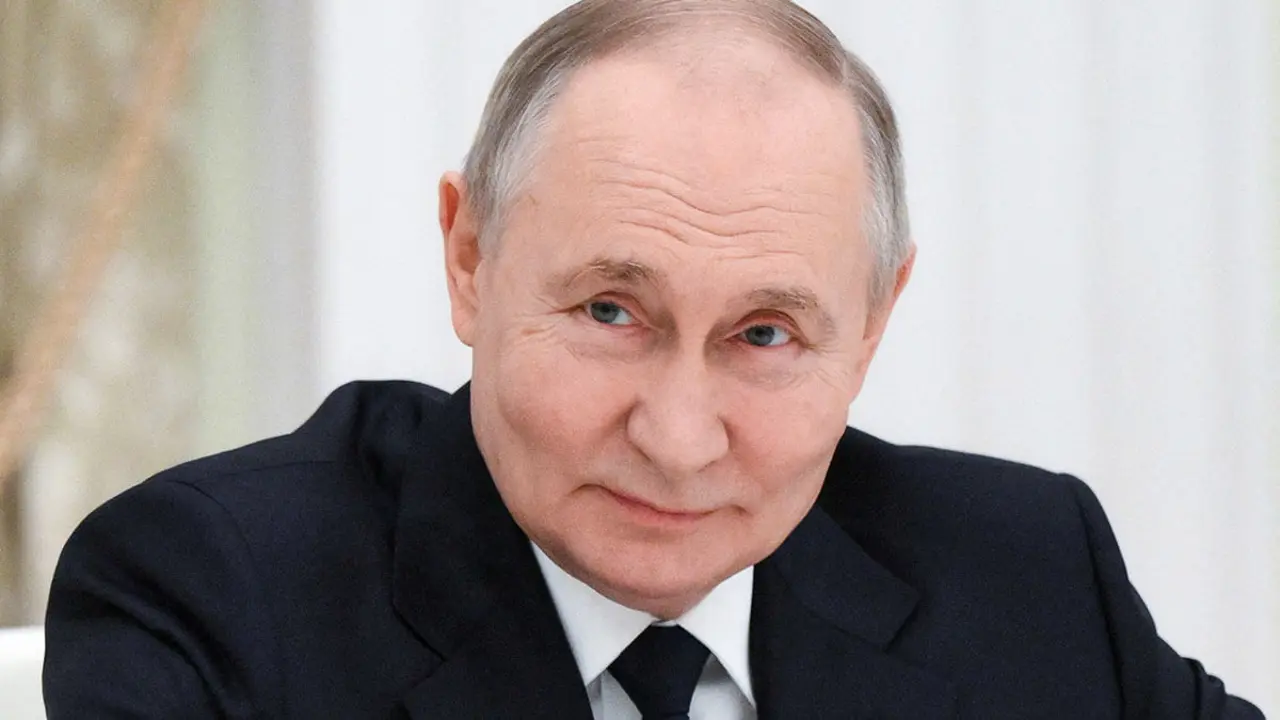Geopolitical assessment of Oman
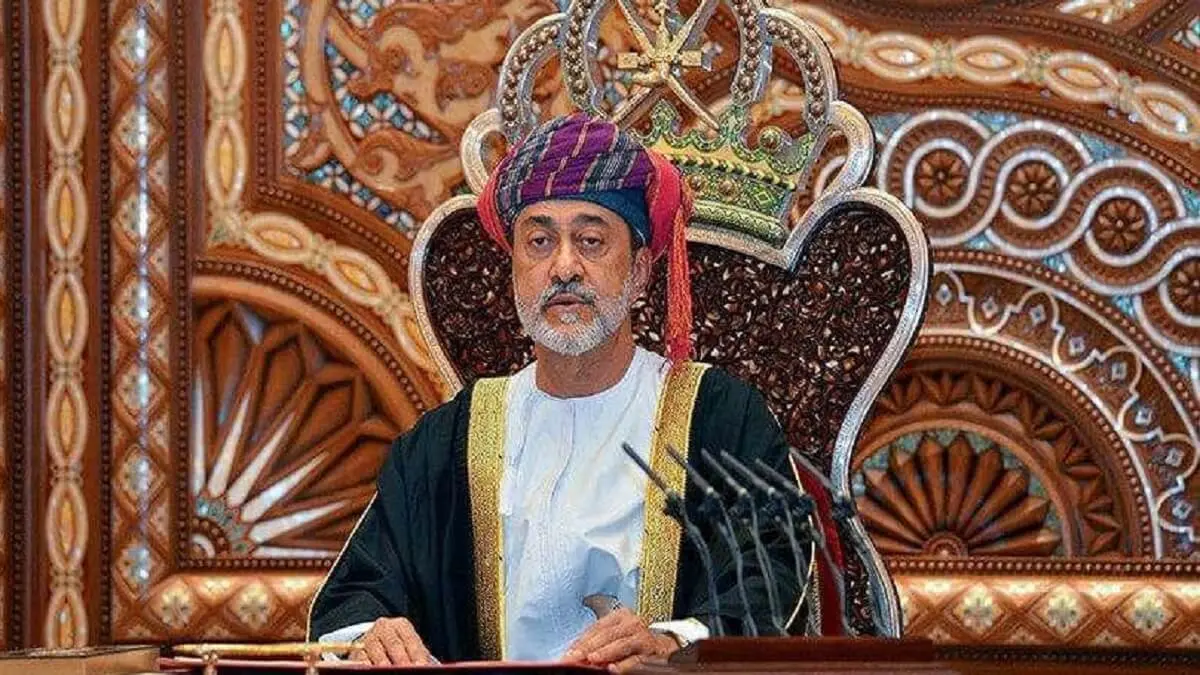
This document is a copy of the original which has been published by the Spanish Institute for Strategic Studies at the following link.
The Sultanate of Oman has important strengths that could favour a stable situation. Geographical position is the country's greatest asset: Located at the entrance to the Strait of Hormuz and in the Indian Ocean, its three ports are vital to global maritime trade. Oman is also very respected in terms of mediation and Muscat has achieved a high profile as a centre for diplomatic negotiations aimed at reducing conflict in the Arab region. The social cohesion of the nation is strengthened by Ibadi Islam, a doctrine that does not promote religious rivalry. Mining is one of the most important growing production sectors: There are mines right across the country, which are valuable from the point of view of renewable energies. However, Oman also has weaknesses, one of which is that its scarce oil reserves are close to depletion. In terms of military capabilities, its defence industry is underdeveloped as the country has been a major arms importer and is highly dependent particularly on the UK for defence and security.
The geopolitical analysis carried out leads us to conclude that the likelihood of conflict in Oman is medium because the Port of Duqm is the meeting point of two opposing actors - the US and China - and this enclave in the Indian Ocean is already an unstable space.
Introduction
Oman is the only state in the Arabian Peninsula whose system of government is a sultanate1, hereditary among the male descendants of Turki bin Said (1832-1888).
The Sultanate of Oman, formerly the Sultanate of Muscat and Oman, was established in 1970 following the coup d'état lead by Sultan Qaboos2, who overthrew his father Said bin Taimur. At that time, the territorial domain of the Omani state, occupying approximately 300,000 square kilometres in the southwest of the Arabian Peninsula, was already unified. Nonetheless, its borders were not finalised until between 1982 and 1992. At present, the sultan is Haitham bin Tariq, who ascended the throne in 2020 when his cousin Qabus died without heirs. Notably, both political authorities come from the same lineage, the Al Bu Said, whose origins date back to the 18TH century.

The purpose of this paper is to analyse Oman's politico-strategic elements. A priori, there is no evidence of historical, religious or ethnic rivalries in the country's history, and neither are there any serious deficiencies in its economic structure that could lead to a crisis3. Oman is, in fact, a nation with significant strengths that facilitate a stable situation:
First, the Omani capital is at the core of Arab politics. In fact, Muscat has become an important centre for mediation in Middle Eastern conflicts, due to the ruling family's tendency towards moderation and neutrality in foreign relations. Oman is thereby strengthening its international leadership in the field of peacebuilding. Talks to reduce the rivalry between Iran and Saudi Arabia, the nuclear deal with Iran and the war in Yemen are some of the recent negotiations that have taken place in this country.
Furthermore, Oman's geographical position favours its international maritime connectivity, which is being consolidated thanks to three major ports: Salalah, Duqm and Sohar. In terms of its economic structure, it has a mining sector with large reserves spread across the country, and there are around 300 mining projects . In October 2022, Oman announced its Green Hydrogen Strategy, the aim of which is to make the country a global production hub.
Last, Oman holds the religious leadership of the Ibadi rite, a determining factor in its cultural identity that gives it internal cohesion and also serves to counterbalance the strength of Saudi Wahhabism and Iranian Shiism. While the population is very heterogeneous, the different groups are not discriminated against in their participation in institutions.
Oman also has major weaknesses, which are shared by the other five monarchies in the Arabian Peninsula:
Economically, it is dependent on hydrocarbons, and it needs to diversify into non- oil activities. With this objective in mind, in 1991 development plans were drawn up, and Vision 2040 has now been projected4. One of its main elements is urban development, focusing on projects for two cities on the Batina coast: a tourist and residential city in Yiti (Muscat), designed by Kettle Collective, a UK-based architecture firm; and the city of Sultan Haitham5 in Seeb in the northwest of Muscat.
Regarding its military capabilities, Oman has a very underdeveloped defence industry, having been a major importer of arms6. It has limited capabilities and manpower to defend its maritime interests. The country is also highly dependent on the UK, with whom it has historically maintained a close relationship.
Last, Oman has a very high proportion of migrants and refugees: 2,073,292 people, out of a total population of 4.6 million7. To balance this ratio, there was a drive to make the workforce mainly Omani nationals, but Omanisation policies have not been greatly successful. In fact, more than half the active population is employed in the public sector, resulting in a large state debt, a reality that will have to be transformed if the country is to adapt to the future decline in oil reserves.
Fortresses of the Sultanate of Oman
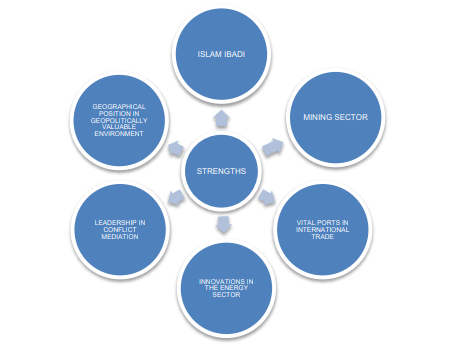
Leadership in Middle Eastern Conflict Mediation
The region of the Persian Gulf is an area with a major impact on international relations and the world economy. Within this highly valuable environment in geopolitical terms, Oman presents itself as a non-aligned country that is very involved in the field of mediation. In this regard, it did not take part in the 2017 blockade of Qatar or in the military intervention in Yemen led by Saudi Arabia and the United Arab Emirates (UAE).
In recent years, Muscat has become a mediation centre where many of the defining tensions in the Middle East are addressed:
Following the start of the invasion of Ukraine, Oman was the first Gulf Cooperation Council (GCC) country to visit Russian Foreign Minister Sergey Lavrov, who assured his Omani counterpart, Badr al-Busaidi, that he was committed to restoring the 2015 Iran nuclear deal8.
On Syria, Oman was the first GCC country visited by Syrian President Bashar al- Assad after the February earthquake. The earthquake in Turkey and Syria has particularly contributed to improving Turkey's relations with the GCC countries, who provided Turkey with humanitarian and financial aid9.
Prior to China's decisive intervention, diplomatic efforts to reduce tensions between Saudi Arabia and Iran had begun in 2021 in Muscat, with five rounds of negotiations involving Iraqi Prime Minister Mustafa al-Kadhimi.
However, the mediation activity in which Oman is most active is the armed conflict in Yemen, where it has made attempts to promote a truce10, mediation or a peace plan.
The UN Special Envoy for Yemen, Hans Grundberg11, has met on numerous occasions in Muscat with Omani officials and Mohammed Abdulsalam, chief negotiator for the Houthi rebel group.
Following the restoration of diplomatic relations between Saudi Arabia and Iran on 10 March, talks are now once again under way in Muscat to reach a peace agreement in Yemen.
Dialogues on the Yemeni conflict are also taking place in other Maxreq cities12 . Following the truce, an agreement was reached in Amman, Jordan, between the Iranian and Saudi delegations for the exchange and release of prisoners13. In April, a meeting between the head of the Houthi Supreme Political Council, Mahdi al-Mashat, and the Saudi ambassador to Yemen, Mohammed Al-Jabe, was held in Sana'a, Yemen. Last, in Abu Dhabi (UAE), meetings between the chairman of Yemen's Presidential Leadership Council, Rashad Al Alimi, and Emirati President Mohamed bin Zayed went on throughout May.
Oman has no diplomatic relations with Israel and the rift between the two countries has widened further since the election victory of Prime Minister Benjamin Netanyahu14.
Geographical position
Oman15 is located on the southwestern tip of the Arabian Peninsula, at the entrance to the Strait of Hormuz. It is the country in the Persian Gulf with the smallest coastline and is only accessible from the northern tip of the Musandam Peninsula.
Oman has a land mass of 300,000 square kilometres, 1,700 kilometres of coastline and 1,414 kilometres of land borders (676 with Saudi Arabia, 450 with the UAE and 288 with Yemen). In 1982, the country signed a security pact with Saudi Arabia that ended its territorial disputes, and the border with Yemen was finalised in 1992.
The small territory on the rocky Musandam peninsula is known as Ras al Jibal and extends to Hisa Diba on the UAE border. Meanwhile, a large, rocky and rugged coastline separates Musandam from the southern cities. This mountain barrier has two inlets surrounded by high cliffs.
The Batina Plain then extends as far as Cape Ras al-Hadd, the south-eastern tip of the Arabian Peninsula, on the coast of which lie the port and major urban centre of Sohar and the capital, Muscat. Further south, the island of Matina stands out.
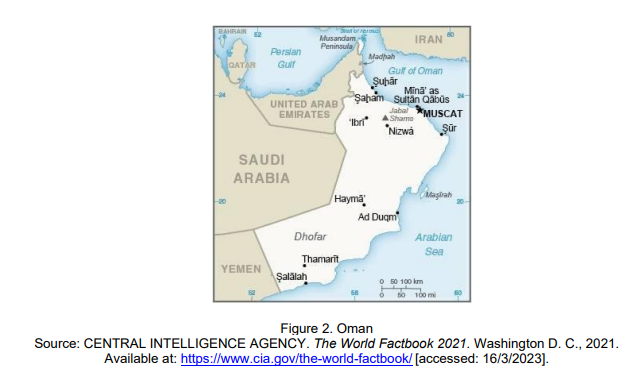
The interior of Oman consists of a large desert area, part of Rub al-Khali, and the Yebel Adjar Mountains and their foothills.
Some 1,200 kilometres south of Muscat lies the Dhofar region. Its important capital, Salalah, was the permanent residence of Sultan Said bin Taimur and the birthplace of his son, Sultan Qaboos.
The Gulf area's maritime trade hub and the booming mining sector
The Omani government plans to turn the country into a maritime trade and logistics hub in the Gulf area and, in line with its Vision 2040, has invested heavily in the port network in recent years16.
On the coast of Batina, at the entrance to the Strait of Hormuz17, is the port of Sohar, which is vital for trade relations. The most important project relating to this enclave was signed in September 2022: the creation of an Omani-Emirati railway company18 to connect the port of Sohar to the UAE rail network. Oman does not have a rail network and this connection is a hugely important strategic objective, enabling the obligatory passage of certain types of goods through Hormuzto be avoided.

In the south, the main port is Salalah, ranked by the World Container Port Performance Index (CPPI)19 as the second most efficient in the world.
In terms of Chinese economic injections into the Indian Ocean ports, located in the east around a sparsely populated area is Duqm, the main pole of investment in the country.
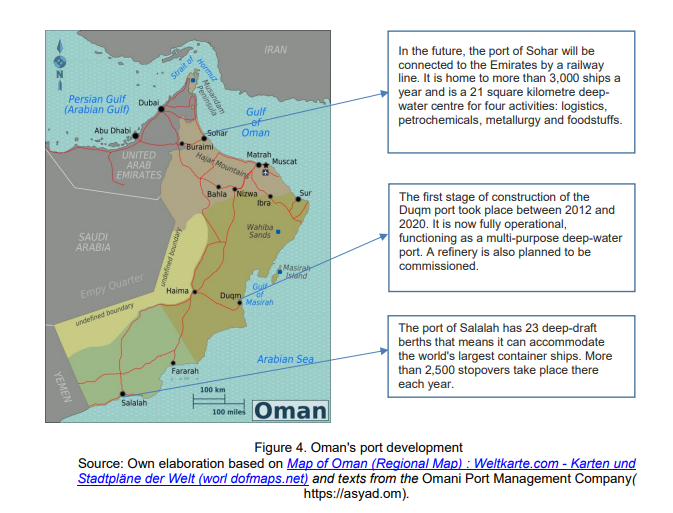
The mining sector20 has also experienced strong growth and is considered one of the priority industries in the government's 2016 Tanfeeh programme. The Omani state is taking over production and export through a set of state-owned21 and private companies, and other private investment channels.
Mining resources are spread throughout the country, although they are concentrated in the Sohar region, the centre of the area near Duqm and the Dhofar region. There are large reserves and a significant variety of metallic (copper, chromite, chromium, aluminium, gold, ferrochrome, cobalt, iron and zinc) and non-metallic minerals (clay, limestone, marble, quartz, salt, gypsum, ceramic clay, potash, dolomite, basalt and phosphate).
In the midst of the energy transition, Oman has minerals for wind and photovoltaic power generation (iron, copper, zinc, aluminium) and for the construction of electric vehicles, storage devices (iron, copper, cobalt) and electricity grids (steel, copper and aluminium).
Oman also has non-metallic minerals for the production and export of building materials, which is of particular importance given the process of urban development taking place domestically and in neighbouring countries. China is also experiencing a bullish cycle in housing construction, requiring these raw materials.
Innovations in the energy sector
Oman is focusing on the most active technologies in renewable fuels, i.e.CO2 capture in industry and hydrogen production.
The Indian company Jindal Shadeed Iron and Steel (JSIS)22 owns and operates a steel complex in the port of Sohar. In June, it will install a pilot carbon capture plant with the aim of collecting 7.5 tonnes per day over the next four years once commercial installation is achieved.
In October 2022, the Omani government presented the Green Hydrogen Strategy23, which aims to make the country a global production hub and achieve 30 gigawatts of generation by 2040. As a platform for project promotion and development, the Ministry of Energy and Minerals regulated Hydrogen Oman (Hydrom)24, an agency under the state- owned Energy Development Oman (EDO).
Ibadi Islam is a force for social cohesion
Oman has approximately 4.6 million inhabitants and a very heterogeneous population composition. A large majority are Arabs, but there are also Baloch communities from Iran and Pakistan, who have gradually concentrated in Muscat and on the Batina coast, where they play an important role in the armed forces. Added to this is the population of its former African colonies, the Omanis of Zanzibar, who had a large presence in the police force. The African population also speaks Swahili. The Khoja community, of Indian origin, is established in Matrab and its members constitute a business elite. Arabic and Farsi are spoken on the Musandam Peninsula.
In terms of religion, the majority are Ibadi Muslims. Sunnis constitute approximately 25% of the population and are located in the vicinity of the Dhofar region. Duodeciman Shi'ism is present in the coastal area.
Given this population and religious variety, and far removed from any rigorism, the Ibadi school is a force for social cohesion, capable of generating a strong sense of identity and containing other more active movements such as political Islam, the intolerant and intransigent Saudi Wahhabism and Shiism. Moreover, the Ibadi school is a source of prestige, attracting the attention of religious scholars in the international research community.
Ibadi Islam is derived from Kharijism, which rejected succession to the caliphate by inheritance; the imam, by contrast, was chosen for his piety and religiosity. This heterodox current split into several sects, one of which was Ibadism, which emerged in Basra during the Abbasid dynasty and established itself in Baghdad (760-1258) as a more moderate form of Kharijism. Ibadism recognised the need for a government and social organisation led by an imam elected by the community. The movement soon began to be repressed and its leaders emigrated to South Arabia (Oman) and North Africa (Libya, Tunisia and Saharan Algeria).
In Oman, the Ibadis settled in inland areas due to the isolation of the mountainous regions. By the 11TH century, Oman had gained independence from the Abbasid caliphate. The first imam was Julanda bin Masood and, in principle, the imamate achieved the unification of the tribes through its egalitarian conception and power of arbitration.
The Persian administrative title of Julanda was the name given to the first Ibadid imams who ruled in the interior. However, as Ibadism evolved up to the 13TH century, power was ephemeral, and subject to constant re-election with each new generation.
From this isolated milieu, Ibadism was gradually introduced on the coast between 1650 and 1725. Imams from the Yaruba family moved to Muscat, where they re-established the Ibadi Imamate on the Batina coast. This move marked the end of the itinerancy of the imams from the interior. The establishment of the Imamate in Muscat facilitated the adoption of Ibadism when the present-day Al bu Said lineage settled in Muscat from 1784 onwards. Ibadist Islam spread and still survives in Mozambique and on the island of Zanzibar, due to Oman's maritime relations with the coast of Africa up to the end of the19TH century 25.
Weaknesses of the Sultanate of Oman
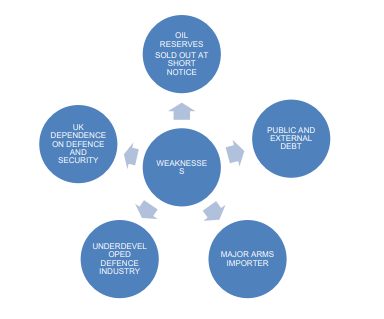
The productive sectors
Oman's economic development began in the 1970s based on oil production and exports. It is currently the country with the lowest reserves in the GCC, and it is estimated that these will be exhausted within fifteen years26.
The Anglo Persian Oil Company (AIOC), later British Petroleum (BP), carried out exploration in Oman in 1924. When no positive results were forthcoming, the licence was awarded to another consortium with Dutch and later French interests. The company that discovered the first field in 1962 in the Al Jibal area was called Petroleum Development Oman (PDO). Prospecting continued from then on in the north and, since 1982, the region has been home to the country's six main production areas for light crude oil, ideal for the refining industry. Heavy crude oil, useful for infrastructure (asphalt), is produced in the south.
At the end of the 20TH century, the national oil companies were established27. In 1974, Oman acquired 60% of PDO until its semi-nationalisation. In 1991, the oil industry accounted for 82% of state revenues and enjoying a period of growth until 2014 thanks to high prices. However, between 2015 and 2021 the balance of payments was negative, and Oman faced large public and external debt. During the first half of 2022, the country again experienced a surplus due to higher oil prices28.
Gas is mainly used for domestic consumption and electricity generation. Since the discovery of the Al Jiba field, the government has pushed for agreements with foreign companies through exploration concessions. Energy relations with Iran are important, dating back to 1992 when negotiations were first initiated for the joint development of gas exploration in the offshore Bukha and Hengam fields, a plan that was attempted to be revived in 2015. Last, in May 2022, Iranian President Ebrahim Raisi and Sultan Haitham bin Tariq reached an agreement in Muscat29 to jointly exploit the Hengam oil field, located in the Persian Gulf in a common maritime space30 near the Iranian island of the same name, and to exchange petrochemical products and engineering and technical know- how.
Military capabilities
Oman has an armed forces31 to protect its territorial integrity and defend its maritime interests. It has an underdeveloped defence industry, and between 2012 and 202132 it was one of the world's largest arms importers. Its military spending rose from the time of the Arab Spring onwards, later stabilising and finally declining in 2021.
The ground forces are sizeable (25,000 troops) and are well equipped with armoured vehicles and modern weaponry from the UK (Challenger). Air defence systems are focused solely on point defence, i.e., dealing with threats to government facilities, ports and energy resources when reaction time is not short.
Oman's naval force is understaffed. Its three frigates from the UK are relatively modern and have relevant capabilities, while the US corvettes and amphibious ships are rather more outdated (both are over 25 years old). Regarding relations with the GCC, agreements with the UAE to coordinate coastal protection measures against smuggling stand out.
Oman's close relationship with the UK means that defence and security arrangements are maintained and continue to develop, explaining the presence of British military personnel to train Omani forces and conduct naval exercises. Military cooperation with the US is less important. However, both countries have air and naval logistical support facilities deployed in the Port of Duqm. In parallel, Oman's ties with China and India, with which it has conducted joint exercises, have been strengthened.
Two major naval exercises took place in March in the Indian Ocean and in the Gulf of Oman: an international exercise involving 50 countries (IMX), and one conducted by the navies of Iran, Russia and China33.
Conclusions
On analysing its political-strategic characteristics, it can be concluded that the probability of conflict in Oman is medium, stemming from the possible collision of rival powers on its territory (Port of Duqm) and the shortcomings of its economic structure.
Leadership
The ruling family maintains internal stability34. The succession problem generated in 2020 was resolved by the enthronement of Haitham bin Tariq, a new actor who did not change the political conditions.
The Al Bu Said lineage, which came to power in the 18TH CENTURY, has become the ruling dynasty. It undertook the state and territorial construction of Oman with the help of the UK. The energy resources discovered during the time of Sultan Qaboos later favoured the political consolidation of the sultanate.
Regarding religion, Ibadi Islam is a means of social cohesion because it is a doctrine that does not promote religious rivalry and supports the integration of the other religions practised in Oman. Consequently, religion is not a belligerent factor and will generate stability in the medium term.
However, Oman's religious harmony contrasts in its immediate surroundings with Saudi Arabia and Iran, whose religiosities are indeed belligerent components that cause tensions. Both are characterised by severity and intolerance, and conservative religious circles do not offer the increasingly educated young population any solutions.
Last, in Oman, human settlements are located along the 300-kilometre Batina coast and inland valleys, where two new city projects will be developed.
International relations
Oman is a highly respected mediator and Muscat is expected to become increasingly visible as a centre for diplomatic negotiations aimed at reducing polarisation in the Arab region.
Relations with Iran will remain stable because of agreements to exploit the oilfields in their common maritime space. The same is true for the Russian Federation, where Oman imports 61% of its wheat.
Regarding Israel, the US may press Oman to sign the Abraham Accords, as it is the second largest investor in the world. However, the likelihood of Oman joining the agreements is slim, as it would lose its peacekeeping leadership and the decision could seriously affect relations with Iran.
Infrastructures and communication routes
Oman's geographical position is the country's greatest asset, given its fortress-like location at the entrance to the Strait of Hormuz and on the Indian Ocean.
Oman's three ports (Salalah, Sohar and Duqm) are its vital hubs, forming the major gateways for imports and exports. If these critical infrastructures were attacked, trade flows could be disrupted, and the Omani economy would be severely damaged.
Another valuable infrastructure for trade relations in the medium term will be the rail network between the port of Sohar and the Emirates.
Last, China is a maritime trading power and is likely to increase its investments in ports - particularly in Duqm - and in commercial and industrial facilities. Since China has no military bases in Oman, the Port of Duqm can serve as a support base. In the longer term, Beijing is likely to deploy naval warfare assets to protect its maritime interests.
Basic resources
Oman's economic structure is seriously flawed. The surplus in 2022 due to the increase in oil prices therefore served to correct its balance of payments. It is the country with the least oil reserves in the GCC, and these will be depleted in the short term. Consequently, Oman has a smaller security cushion than the surrounding monarchies to diversify its economy before 2040.
Although only 3% of Oman's mineral deposits were being exploited in 2020, the economic context is very favourable for the country to take advantage of its mineral raw materials: the fight against global warming is closely linked to mineral consumption35 and the general trend suggests that demand for minerals will quadruple by 2050.
In the current energy transformation landscape, like Saudi Arabia and the UAE, Oman will focus its investment efforts on developing methods to capture and storeCO2 and on green hydrogen.
In terms of the goal of becoming the world's hydrogen production centre, Oman has a low penetration of renewable energy36. Specifically, hydrogen is a fuel that still requires a lot of research on three technological aspects: production (it is not an energy source and energy must be generated), storage and supply37. Consequently, for the viability of this fuel, a long-term time horizon of around twenty years, or beyond 2030, is estimated.
Threats and Armed Forces
Oman's Port of Duqm is a meeting point for opposing actors (the US and China), an enclave in the Indian Ocean that could become an area of unrest or the scene of war in the medium to long terms38.
The US and British navies therefore have a presence in this port enclave - with air and naval support facilities - which is also the hub of Chinese investment in the country. For
the time being, however, Oman is able to integrate these antagonistic forces because it maintains strategic relations with both.
Oman will almost certainly remain dependent on British military equipment. The UK's naval diplomacy in Oman through naval exercises ensures that its companies and arms industry remain well positioned in the country.
Last, regarding borders, Oman shares 288km with Yemen, a highly unstable country. It is believed that Oman will continue to mediate to achieve a peace agreement between the different actors in the Yemeni armed conflict. However, the migratory movement between the Horn of Africa and Yemen via the eastern route runs along one of the busiest maritime corridors in the world, and has a major impact on the migratory context of Oman and the Arabian Peninsula in general39.
Natalia Torregrosa Ramos*
IEEE Analyst
References:
1 The term sultan has different meanings. First, the Ottoman Sultan was considered the lord of all believers. Amir Osman I proclaimed himself sultan in 1281, having united the Turkish tribes between Syria and Asia Minor under his authority. Second, there were sultanates in Yemeni territories bordering Oman. In this case, the sultan was the protector of the various tribes located in his lands. However, neither was particularly well armed and they exercised little control outside the walls of their capitals. There were the merchant sultans in Oman, who fought over the coastal cities. One of them belonged to the Al Bu Said family, the seed of the current dynasty, whose capital was located in Muscat from 1784.
2 Oman's bank holiday is 18 November, the birthday of Sultan Qaboos.
3 This geopolitical assessment of Oman is based on some of the belligerent factors classified in the IEEE Notebook Factor Analysis of the Causes of Conflict (No. 69, 1994) and Federico Aznar Fernández- Montesinos' La ecuación de la guerra ( Montesinos, 2011).
4 Like Oman, the other five countries of the Arabian Peninsula - Saudi Arabia, Bahrain, United Arab Emirates, Kuwait and Qatar - are implementing government plans to diversify their economies to face a possible scenario of declining oil reserves (Visions 2030, 2035, 2040, etc.) (TORREGROSA RAMOS, Natalia. "Vision 2030 in Saudi Arabia" [IEEE Analysis Paper, 24/2023]. Available at: https://www.ieee.es/contenido/noticias/2023/03/DIEEEA24_2023_NATTOR_Arabia.html).
5 OBSERVER WEB TEAM. "His Majesty launches Sultan Haitham City", Oman Observer. 31 May 2023. Available at: [accessed: 07/6/2023].
6 SIPRI. "World military spending falls, but China, Russia's spending rises, says SIPRI". 15 April 2023. Available at: https://sipri.org/media/press-release/2013/world-military-spending-falls-china-russias- spending-rises-says-sipri [accessed: 13/6/2023].
7 INTERNATIONAL ORGANISATION FOR MIGRATION (IOM). "Gulf Cooperation Council countries", in Situation Report on International Migration 2019.The Global Compact for Safe, Orderly and Regular Migration in the Context of the Arab Region. United Nations, 2020, pp. 34-40. Available at: https://publications.iom.int/books/situation-report-international-migration-2019-global-compact-safe- orderly-and-regular
8 STRATFORD WORLDVIEW. "Oman, Russia: Lavrov's Visit to Muscat shows bilateral relationships are unchanged". 12 May 2022. Available at: https://worldview.stratfor.com/situation-report/oman-russia- lavrovs-visit-muscat-shows-bilateral-relationships-are-unchanged
9 Syria rejoined the Arab League on 19 May, following its expulsion on 12 November 2011.
10 The last truce period in Yemen lasted for six months, between 1 April and 2 October 2022.
11 Swedish diplomat Hans Grundberg has held the post since 10 August 2021, when he replaced British diplomat Martin Griffiths, who had been the UN special envoy for Yemen since February 2018.
12 The Maxreq or Machrek is a group of thirteen countries: Egypt, Jordan, Palestine, Lebanon, Syria, Iraq, Kuwait, Bahrain, Qatar, United Arab Emirates, Oman, Saudi Arabia and Yemen (KHADER, Bichara. The Arab world explained to Europe: history, imaginary, culture, politics, economics and geopolitics. Icaria, 2010, p. 347).
13 BBC MONITORING. "Yemen's Houthis, Saudi-led coalition exchange visits to prisoners". 13 October 2022.
14 Saudi Arabia and Oman have no diplomatic relations with Israel, but they have been keeping their airspace open to Israeli commercial flights since July 2022 and February 2023, respectively.
15 Geographical, historical and cultural aspects of Oman have been covered in these monographs: MINISTRY OF INFORMATION. Oman in History. Sultanate of Oman. 2016.
METZ, Helen Chapin (ed.). "Oman", in Persian Gulf States: Country Studies (3.a ed.). Federal Research Division, Library of Congress, Washington D. C., 1994, pp. 259-262.
PLANHOL, Xavier de. "Oman", The Nations of the Prophet, Handbook of Muslim Political Geography.
Bellaterra, 2000, p. 138-154.
16 BUSINESS REPORTER. "Omani ports register 8% growth for all operations in 2022", Oman Observer. 17 April 2023. Available at: https://www.omanobserver.om/article/1135820/business/economy/omani- ports-register-8-per-cent-growth-for-all-operations-in-2022 [accessed: 08/6/2023].
17 The Strait of Hormuz moves more than 40% of China's energy supply (SAMPER, V., DE VICENTE, A., and JIMÉNEZ, E. (2022). "China as a global actor and its relations with Africa, Mediterranean countries and the Middle East', ICE Economic Bulletin, No. 3153. December 2022, p. 53-54. Available at: https://doi.org/10.32796/bice.2022.3153.7537
18 The top three investors in Oman worldwide are, in this order, the UK, the US and the UAE.
19 https://www.omanobserver.m/article/1137590/business/salalah-port-second-most-efficient-port-in-the- world [accessed: 07/6/2023].
20 ICEX. The mining sector in Oman. Economic and Commercial Office of the Embassy of Spain in Muscat, 2020. Available at: https://www.icex.es/content/dam/es/icex/oficinas/076/documentos/2020/07/documentos- anexos/DOC2020855721_2.pdf
[accessed: 07/6/2023].
21 OMAN NEWS AGENCY (ONA). "Three concession agreements inked for extracting potash, lithium",
Oman Observer. 30 May 2023. Available at:
https://www.omanobserver.om/article/1137949/oman/three-concession-agreements-inked-for-extracting- potash-lithium [accessed: 09/6/2023].
22 PRABHU, Conrad. "Omani steelmaker plans carbon capture pilot", Oman Observer. 8 June 2023. Available at: https://www.omanobserver.om/article/1138425/business/economy/omani-steelmaker-plans- carbon-capture [accessed: 09/6/2023].
23 The technologies nowadays becoming more active in renewable fuels areCO2 capture and hydrogen production (CABELLO CALVO, Berta. "Ecofuels and synthetic fuels and their role in the current landscape", Energy and Geostrategy Notebook 2023. The Spanish Institute for Strategic Studies, p. 93- 145 Available at: https://www.ieee.es/Galerias/fichero/cuadernos/ENERGEO23/Cap2_Ecocombustibles.pdf).
24 Hydrom signed the first project agreements in June 2023 during a major event at the Grand Millennium Hotel (Muscat) (OMAN OBSERVER. "Phase A Round 1 green hydrogen project agreements to be signed tomorrow". 30 May 2023. Available at: https://www.omanobserver.om/article/1137965/business/energy/phase-a-round-1-green-hydrogen- project-agreements-to-be-signed-tomorrow).
25 Omani merchants had a base on the island of Zanzibar so that they could penetrate the interior of the African continent, where they carried out activities related to the slave trade. Steam navigation transformed the previous maritime situation, based on sailing, and the Omanis lost control of international trade. A branch of the Al Bu Said dynasty then declared independence and Zanzibar was emancipated from Oman.
26 Cfr. BONET, Antonio. "The economic opening of unknown Oman". Exporters and Investors Club, 21 November 2022. Available at: https://clubexportadores.org/la-apertura-economica-de-la-desconocida- oman-por-antonio-bonet-empresa-exterior/ [accessed: 05/6/2023].
27 The interesting figure of the Saudi Arabian Abdala al-Turaiki (1920-1997), one of the first Arab experts on oil matters and an ideologue of price fixing and production monitoring by producer states, is studied in these publications:
ROGAN, Eugene. The Arabs: from the Ottoman Empire to the present. Crítica, 2012, pp. 557-574. HERNANDEZ MARTÍNEZ, David. The Kingdom of Saudi Arabia and hegemony in the Middle East.
Los Libros de la Catarata, 2020, p. 43.
28 MEE Staff. "OPEC+ row: Bahrain, Oman insist consensus on output cut after ‘Saudi pressure’ claim", Middle East Eye. 16 October 2022. Available at: https://www.middleeasteye.net/news/opec-row-bahrain- oman-saudi-pressure-consensus-production-cut [accessed: 07/6/2023].
29 LUCENTE, Adam. "Iran and Oman agreed today to jointly develop an oil field in the Persian Gulf", Al- Monitor. 23 May 2022. Available at: https://www.al-monitor.com/originals/2022/05/iran-oman-jointly- develop-oil-field#ixzz7UBZ8YGqt [accessed: 25/4/2023].
30 "The two nations bordering the Strait of Hormuz are Iran and Oman, separated by 20 miles at its narrowest point, and Oman has its strait in the territorial sea for 12 miles" (SANZ ALISEDO, Gonzalo. "Oceans and choke points, opportunities and risks for global maritime trade" [IEEE Analysis Paper, 68/2022]. Available at: https://www.ieee.es/Galerias/fichero/docs_analisis/2022/DIEEEA68_2022_GONSAN_Oceanos.pdf [accessed: 07/06/2023].
31 Information on Oman's military forces is available at: INTERNATIONAL INSTITUTE FOR STRATEGIC STUDIES (IISS). "Oman", The Military Balance. 2023, pp. 346-348.
32 2017 and 2021 SIPRI (Stockholm International Peace Research Institute) yearbooks and an article that reflects the opinion of the same organisation (CENTRE DELÀS D'ESTUDIS PER LA PAU. "World military spending falls, but China, Russia's spending rises, says SIPRI', 15 April 2013. Available at: https://centredelas.org/actualitat/world-military-spending-falls-but-china-russias-spending-rises-says- sipri/?lang=en).
33 Middle East Military Observatory, No. 43, March 2023.
34 Out of 132 countries surveyed, Oman ranks 10th in respect for minorities and 33rd in political stability (INSEAD, ACCENTURE and PORTULANS INSTITUTE. "Oman", The Global Talent Competitiveness Index. 2021, p. 175. Available at:https://www.insead.edu/sites/default/files/assets/dept/fr/gtci/GTCI-2021-
Report.pdf
[accessed: 13/6/2023].
35 Minerals, a strategic issue in the 21st century: Cuaderno de Estrategia, n.o 209. Instituto Español de Estudios Estratégicos, 2022.
36 For comparison purposes, Spain currently generates 6 gigawatts (6,000 megawatts, MW) with 60,000 wind and photovoltaic installations and is considered a country with a high penetration of renewable energies.
37 The production, storage and supply of hydrogen are presented in a pedagogical way: FRONTIER ECONOMICS. " Hydrogen transport: the importance of ammonia". Naturgy Foundation. 06 October 2022. Available at: https://www.youtube.com/watch?v=9eZR8lntETU [accessed: 08/5/2023].
38 "China [...] is leveraging its economic and military power to assert control over global supply chains and critical infrastructure in our region and elsewhere in the world" (WEEL, David van. "New Security Challenges in a Changing Strategic Landscape", The Future of NATO after the Madrid 2022 Summit: Cuaderno de Estrategia, n.o 211. Spanish Institute for Strategic Studies (IEEE), 2022, p. 60. Available at: https://www.ieee.es/Galerias/fichero/cuadernos/CE_211_FuturoDeLaOTAN.pdf).


